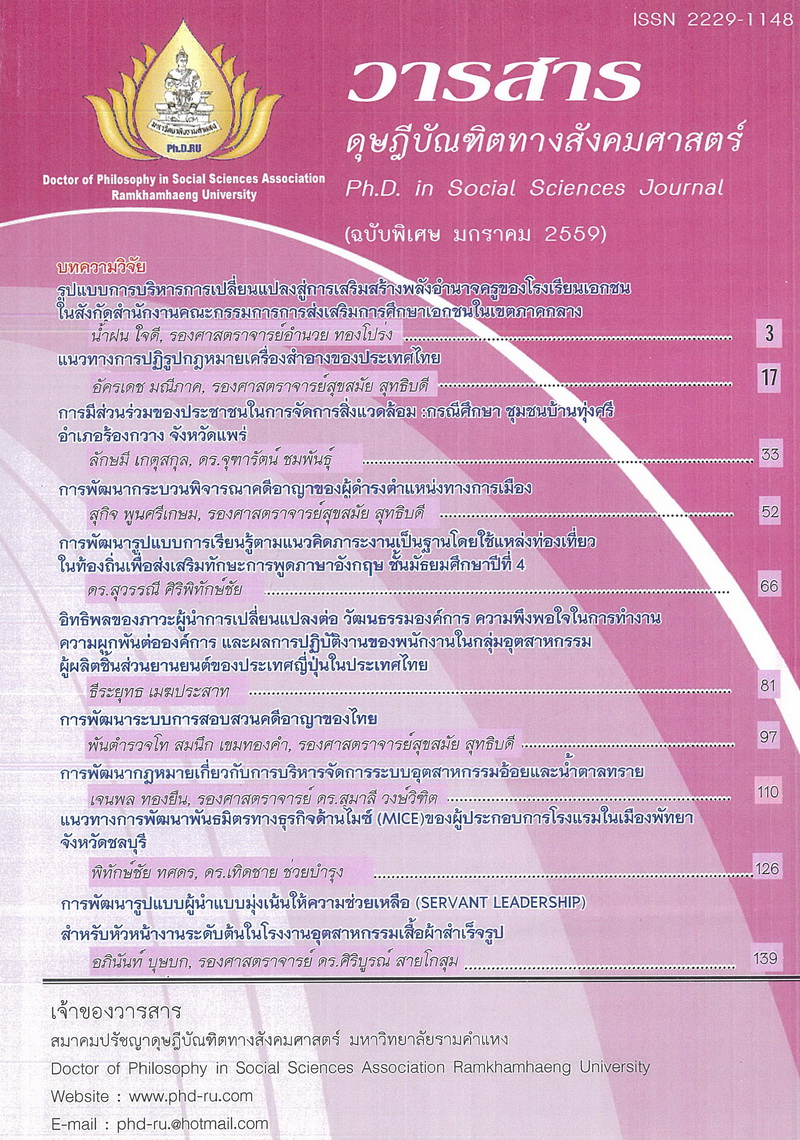แนวทางการปฏิรูปกฎหมายเครื่องสำอางของประเทศไทย
Main Article Content
Abstract
สำหรับหลักเกณฑ์การกำกับดูแล และการควบคุมเครื่องสำอางของประเทศไทยที่มีบังคับอยู่ใน ปัจจุบัน พบว่ากฎหมายแม่บทในการกำกับดูแลเครื่องสำอาง คือ พระราชบัญญัติเครื่องสำอาง พ.ศ. 2535 และมีกฎหมายรองที่เกี่ยวข้องกับการกำกับดูแลเครื่องสำอางอีกหลายฉบับไม่สามารถกำกับดูแลเครื่อง สำอางได้ครอบคลุมทั่วถึง ขาดมาตรการการกำกับดูแล และการควบคุมเครื่องสำอาง ทำให้ไม่สามารถ ผลิตสินค้าเครื่องสำอางได้อย่างมีมาตรฐาน พบปัญหาหรือข้อบกพร่องจากการกำกับดูแล และการควบคุม เครื่องสำอางของประเทศไทย คือ การขึ้นทะเบียนและรับแจ้งเครื่องสำอาง ฉลาก การควบคุมการโฆษณา เครื่องสำอาง การดำเนินการเกี่ยวกับเครื่องสำอางที่ไม่ถูกต้องและความรับผิดต่อความเสียหายที่เกิดขึ้นจาก สินค้าไม่ปลอดภัย การเข้าถึงกระบวนการเยียวยาล่าช้าไม่ทันต่อความเสียหาย อีกทั้งควรปรับปรุงมาตรการ ทางกฎหมายให้มีความสอดคล้องกับบทบัญญัติเครื่องสำอางแห่งอาเซียน (ASEAN cosmetic directive) เนื่องจากเป็นพันธกรณีที่ประเทศไทยต้องปฏิบัติตามบทบัญญัติเครื่องสำอางแห่งอาเซียน
REFORMATION GUIDELINES OF COSMETIC LAWS IN THAILAND
This research aims to study the reformation guidelines of cosmetic law in Thailand from the problems and theory to compare with foreign law to find out the result in accordance with conceptual framework and hypothesis through research design procedure respectively. This research is qualitative research namely documentary and field work study consisting of in-depth interview from 27 experts, brainstorm meeting from 22 experts dividing into three groups, and data examined expertise, and qualitative research namely data analysis from the questionnaire from the samples namely 400 consumers who buy and use cosmetic regularly in Bangkok metropolitan and analyze the result in order to find the guideline for reformation of the cosmetic law suitable for Thailand. The researcher concluded the research result as follows:
The research found that there was Cosmetic Act to control the products made in Thailand or imported products since B.E. 2535 to present, but there was illegal cosmetics products selling in market both unregistered and dangerous liquid mixed in the cosmetic, all these materials are prohibited to use in cosmetic, For the controlling regulations and the protection of the cosmetics of Thailand enforcing at present found that the organic legislation to control the cosmetics is Cosmetic Act B.E. 2535 and other subordinate laws of controlling the cosmetic, these laws unable to support and control cosmetics products, this is the cause of the quality of products. Moreover, the research found that problems and faults of protection and control of the cosmetics in Thailand were the register, the complaining of brand and license, the control of propaganda, the enforcement of the illegal cosmetics products and the responsibility of error form products, the compensation procedure not active. Furthermore there should be law amendment to accordance with the Act ASEAN Cosmetic Directive due to the commitment which Thailand has to follow the Act of ASEAN Cosmetic Directive.
Article Details
Academic articles, research articles, and book reviews in the Ph.D. in Social Sciences Journal are author’s opinions, and not the publisher’s, and is not the responsibility of the Ph.D. in Social Sciences Journal Philosophy Association, Ramkhamhaeng University. (In the case that research is done on human, the researcher has to be trained in Ethics for Doing Research on Human Training and has to produce the evidence of the training).


